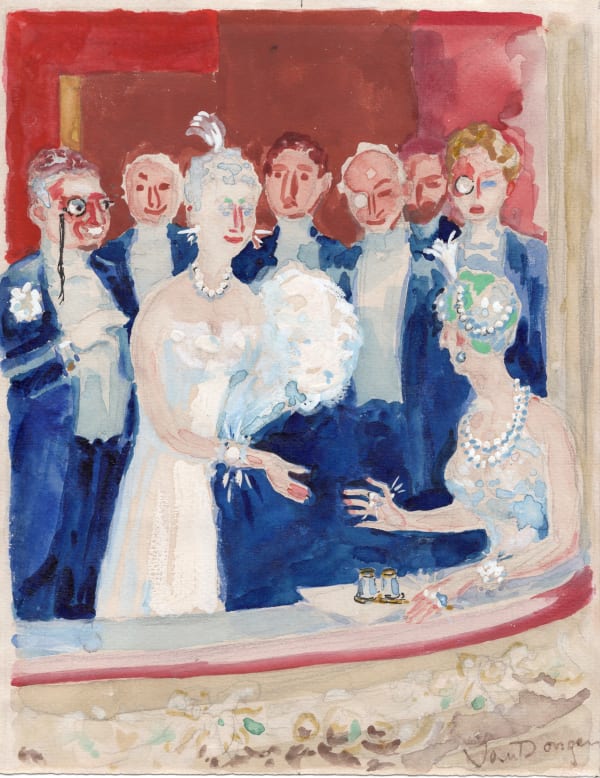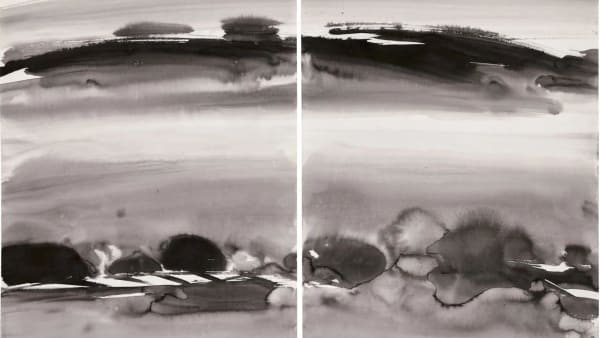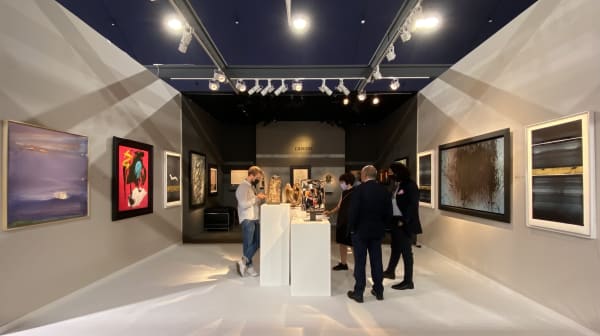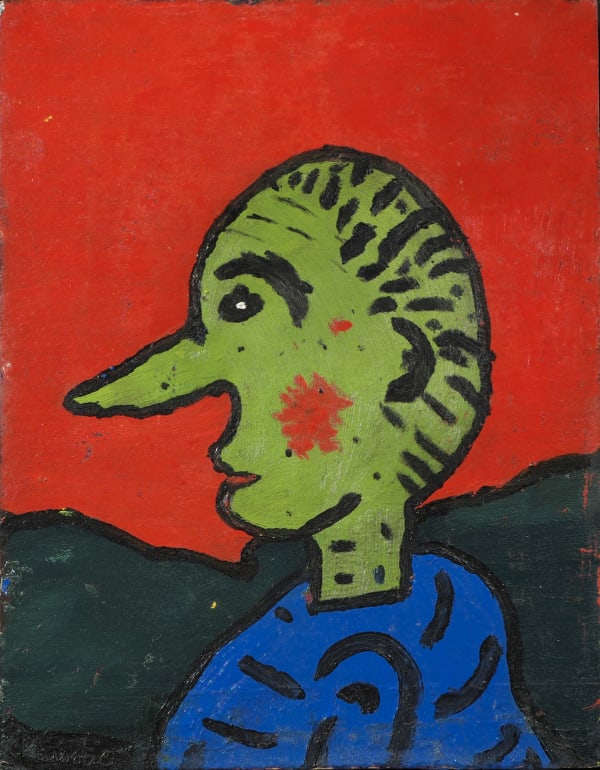Past
-

T'ang Haywen : Ink in Movement
21 - 21 Juin 2025 From the 1960s onwards, T'ang Haywen's work was mainly created in ink, in the great tradition of the eccentric masters of the Qing dynasty, particularly through Shitao's Discourse on Painting. His style developed from calligraphy but, unencumbered by academic conventions, found complete freedom. With a career path similar to that of Zao Wou-Ki, T'ang Haywen assimilated Western painting techniques to create a new, abstract and radically modern form. Plus d'information -

The Surrealist Figure: André Masson, Hans Bellmer and Pierre Jahan
24 Mai - 4 Juin 2025 Surrealism is often an art of metamorphosis and of the deeper desires of the unconscious mind. The confusions of categories between the organic and mineral, the human and the animal... Plus d'information -

Tous Léger! Fernand Léger and his contemporary echoes
30 Avril 2025 The exhibition ‘Tous Léger’ (All Léger) opened recently in Paris at the Musée de Luxembourg, showing how the plastic innovations of one of the masters of the 20th-century avant-garde, Fernand... Plus d'information
-

Pierre JAHAN: The Surrealist Herbarium
1945-1948 22 Février - 7 Mars 2025 'Surrealism... takes great advantage of equivocation and lends itself to a number of transpositions’, said André Breton. I think that the photographer who so much suggests, describes or finds (if... Plus d'information -

Lyrical Abstraction: Judit REIGL and Henri MICHAUX
12 - 26 Février 2025 In France in the Post-War period, Lyrical Abstraction, led by Pierre Soulages, Hans Hartung and Gérard Schneider, becomes one of the most important artistic movements. Its focus was on the... Plus d'information -

Les Nabis : Paul-Elie Ranson and Ker-Xavier Roussel
12 - 26 Février 2025 Under the impulsion of Paul Sérusier and Maurice Denis' new ideas about the very nature of painting (Remember that a picture, before being a battle horse, a female nude or... Plus d'information
-

André Masson: America
9 - 22 Janvier 2025 Fleeing the Occupation, André Masson and André Breton arrive in New York in 1941, after a three-week stay in Martinique. Although impressed by the metropolis, André Masson, as always, found nature far more appealing than the chaotic pace of the city. He settled in New England, near Lake Waramaug, where he was visited by Calder, Kay Sage, Yves Tanguy and Arshile Gorky, and exhibited in the United States, notably with Kurt Valentin and Pierre Matisse.
André Masson's work is one of continuous metamorphosis. In the United States, inspired by the wild, spectacular landscape so different from the more pleasant European landscape, he once again changed his way of painting, even if the mythical theme persisted. His works reflect the fertility of American soils, as well as the violence of extreme atmospheric phenomena. He allows himself to be carried along by new, more dynamic and violent pulsations:
“...the paintings have become infinitely more violent. The influence of climate is indisputable. There's also this terrible, aggressive light, no mist...Seized by the earthly force and violent climate of this region, I seek and perhaps find pictorial correspondences of elemental forces. Telluric mysteries. Phenomena of hatching and germination also find their transposition in numerous canvases and pastels.”
It's impossible not to recall the influence André Masson's American period had on Abstract Expressionism in its early days, and especially on the work of Jackson Pollock. It's likely that Pollock met Masson at Stanley W. Hayter's Atelier 17 in New York, where Masson worked on prints. The two artists shared the same totemic vision of the forces of nature. Jackson Pollock was marked by the presence of surrealist artists during the war: works such as "Moon-Woman Cuts the Circle", 1943, now held in the collection of the Centre Pompidou in Paris, show a vision close to Masson's surrealism of the same period. Plus d'information -

André Masson: A Mythology of Nature
14 - 31 Décembre 2024 Nature represents one of the through-lines in Surrealist André Masson's oeuvre. In 1923, one of his earliest series that captures the interest of Surrealist founder André Breton is his forests, in which the cubist style combines with a more symbolist, philosophical view of nature in order to create strange environments.
On his return from Spain at the end of 1936, André Masson rejoined André Breton's Surrealist group, and took part in the group's International Exhibitions in Paris and London in 1938. Faced with the rise of fascism, and hastened by the Spanish Civil War, Masson held the belief of the Greek stoic philosophers in an eternal return of things. Settling in Lower Normandy in 1939, Masson declared that he was ‘taken back by the poetry of the forest’. But he adopted the posture of a hermit philosopher, that of Heraclitus as described by Nietzsche - ‘the non-consideration of present and instantaneous things making up the essence of the great philosophical nature’.
Between 1938-1939, the artist is working on his Mythologies, a work he considers to be his swan song. The mythical impetus of these large drawings blends with the quest for a universal principle of nature, above all metamorphosis and genitor eroticism. Dans le pur néant shows the desire, the meeting of a mineral couple, gigantic, which feeds the continuous flow of an unfinished world, in perpetual becoming. In this great mythological nature, the plant, the mineral and the human intertwine in a kind of osmosis, a wedding where everything transforms and germinates. As in German Romanticism, especially with Goethe and Novalis, nature is perceived as a supreme truth.
This quest for natural delurium and métamorphosis will pursue with the Martinique drawings, which the artist himself characterizes as a "vegetal delirium". On hiw way to New York escaping the Occupation in 1941, Masson and Breton are stopped in Martinique, where they will remain for a month. There, they are surprised by the discovery of savage, exotic jungles, which will feature heavily in their poetic work, published in "Martinique charmeuse de serpents", which masson illustrates entirely. Much like his earlier cubist forests, nature is presented as a sort of "horror vacui", all-encompasing, organic and hidding a deeper meaning. Plus d'information -

Kees Van Dongen : Illustrator
10 - 31 Octobre 2024 We have the pleasure to present to you two new works by Fauvist painter Kees Van Dongen - both rare originals that served as models for the illustrations of books... Plus d'information
-

André Masson: le surréalisme révolutionnaire
9 Octobre - 30 Novembre 2024 On the occasion of the Surrealist centenary, the gallery has the pleasure to showcase a selection from its exhibition 'André Masson: le Surréalisme révolutionnaire', which is part of the parcourse... Plus d'information -

Picasso's Owls
7 - 7 Juillet 2024 The fact that Picasso liked to surround himself with animals is well known. One day in 1946, as Picasso was working at the Musée d'Antibes, his photographer friend Michel Sima,... Plus d'information -

T'ang Haywen: the Lyrical Landscapes
22 - 28 Mai 2024 Chinese painting is never abstract. As T'ang Haywen says himself, his is an art that never loses touch with the sensible world. In his ink works, which are at the... Plus d'information
-

Nicolas Lefeuvre: Somewhere Between Now and Before
21 - 25 Mai 2024 Galerie Jean-François Cazeau has the pleasure to present the latest works of Contemporary artist Nicolas Lefeuvre. This series, called Somewhere Between Now and Before, wears its title well: it is a transition, a road between the ink Landescapes which consecrated him and his new researches on canvas.
These works are the first the artist ever created on canvas, and the passage to the new medium allows for new aesthetic possibilities, and a new depth of colour. References to past series permeate the new series: the abstract allusion to a kimono, the stamped ink sigils... Plus d'information -

Pablo Picasso: The Vollard Suite
2 - 16 Décembre 2023 Découvrez à la galerie deux des plus importantes planches de la Suite Vollard : le Minotaure aveugle guidé par Mare-Thérèse dans la nuit étoilée et le Faune dévoilant une dormeuse d'après Rembrandt. La mythologie de la Méditerranée y rencontre la mythologie personnelle de Picasso. Plus d'information -

Pablo Picasso : 1968-1971
The thrill of creation 3 - 14 Octobre 2023 Entre 1968 et 1972, Pablo Picasso, déjà âgé de plus de 80 ans, entreprend ses deux dernières grandes œuvres graphiques, comme une sorte de distillation et de célébration de toute... Plus d'information
-

The Modern Still Life: Cubism and Colour
12 - 19 Septembre 2023 Contrairement, ou peut-être parallèlement, à leur ambition révolutionnaire, les avant-gardes du XXe siècle ont souvent choisi de retravailler et de réinterpréter les sujets traditionnels de l'histoire de l'art. C'est ainsi... Plus d'information -

André Dunoyer de Segonzac's Saint-Tropez
22 - 29 Juillet 2023 Born in 1884 in Boussy-Saint-Antoine, near Paris, Dunoyer de Segonzac began his artistic training in Paris in 1903. He attended the Académie de la Palette and the studios of Luc Olivier Merson and Jean-Paul Lorens.
From 1909, Dunoyer de Segonzac regularly took part in exhibitions at the Salon des Indépendants, and exhibited at the Salon de la Section d'Or in October 1912 and at the Armory Show in New York in 1913. His paintings of the period show the influence of Cubism and, to a lesser extent, Expressionism. Mobilised in August 1914, he left Saint-Tropez to join the army corps in Fontainebleau and, during the First War, produced a series of drawings of the trenches. After the war, the engraver Jean Emile Laboureur introduced him to the technique of etching. This was the defining moment in Dunoyer de Segonzac's artistic output, and he never left printmaking until the end of his life: he created more than 1,600 prints.
Between the two wars, Dunoyer de Segonzac was recognised by the critics, along with André Derain and Henri Matisse, as one of the most important modern artists. In 1925, together with Moreau and André Villeboeuf, Dunoyer de Segonzac bought Charles Camoin's villa in Saint-Tropez, which he renamed Le Maquis. Not falling into the trap of the Mediterranean sun, he devoted himself to translating the rare moments of grey light or dark skies, expressing a timeless feeling and a melancholy atmosphere. Looking at Cézanne's work towards the end of his life, he turned more and more to watercolours. It was his watercolours that brought Dunoyer de Segonzac commercial success as well as officielle consecration when he was appointed curator of the Musée de L'Annonciade in Saint Tropez when it was created in 1955. He died in Paris in 1974. Plus d'information -

Herbin / Charchoune : L'Abstraction Symbolique
13 - 22 Juillet 2023 Véritables nomades de l'avant-garde, Auguste Herbin et Serge Charchoune présentent deux voies parallèles et contrastées dans l'histoire de l'art du siècle dernier. Les carrières des deux artistes traversent les mouvements... Plus d'information
-

BRAFA Art Fair 2022
19 - 26 Juin 2022 Plus d'information -

The Sculpture in all its Forms
16 Février - 21 Mars 2022 Plus d'information -

Portraits from 1928 to Nowadays
2 Février - 7 Mars 2022 Plus d'information
-

La Couleur dans l'art
13 - 31 Janvier 2022 Ajoutez de la chaleur et de la richesse à votre collection d'art avec une œuvre d'art de la Galerie Jean-François Cazeau. Nous avons sélectionné quelques œuvres aux couleurs saturées et... Plus d'information -

Art Paris 2021
7 - 12 Septembre 2021 Plus d'information -

La faune et la flore
Fauna and Flora 2 Octobre - 13 Novembre 2020 De Picasso à Masson, les maîtres modernes du 20e siècle trouvent dans la faune et la flore beaucoup d'inspiration. Cette exposition rend hommage à la nature derrière ces œuvres et... Plus d'information
-

Formes et corps dans l'art à travers les siècles
The Figure and Body in Art Through the Centuries 17 Juillet - 3 Septembre 2020 Nothing might have evolved so much as the representation of the human form over the course of the last centuries. The human ideal has transformed from an original idealisation of... Plus d'information -

Portraits de Maîtres
16 Juin - 16 Juillet 2020 Portraiture is said to have originated over 5000 years ago. However, it is in the 20th century that portraiture seems to have evolved the most, from figurative, to cubist, to... Plus d'information -

Discover Abstraction with Sudaporn Teja
A selection of works by Thai contemporary artist Sudaporn Teja 31 Mars - 23 Mai 2020 Plus d'information



























